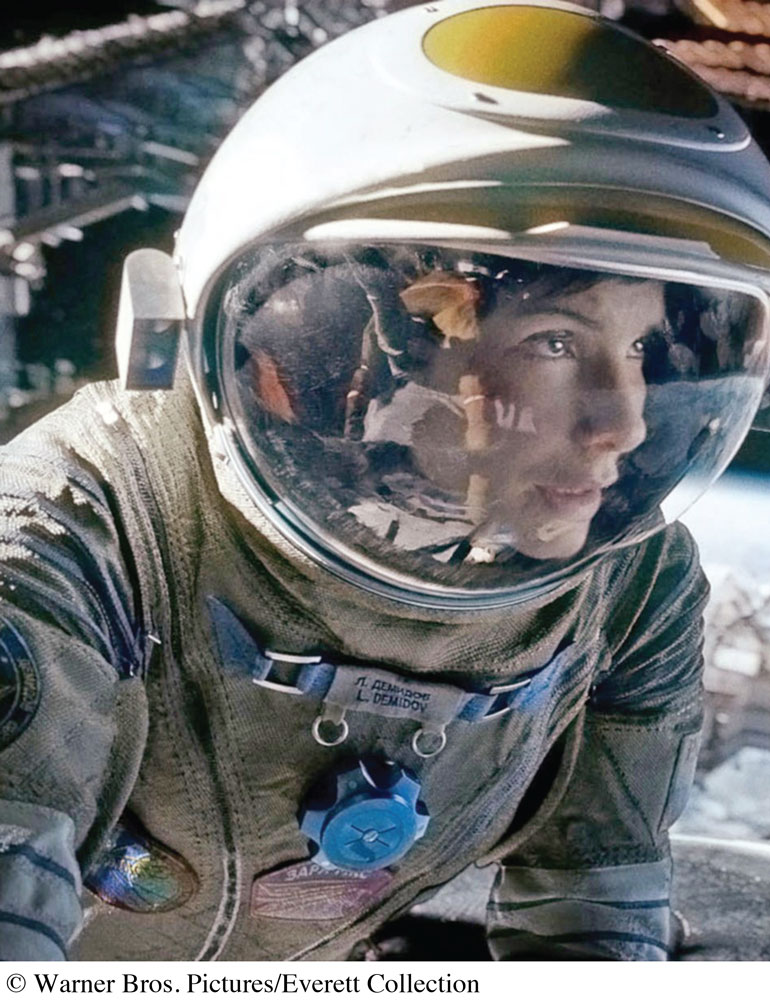Chapter Introduction
7
Movies and the
Impact of Images

217
The Early History of Movies
The Evolution of the Hollywood Studio System
Hollywood’s Golden Age: The Development of Style
The Transformation of the Hollywood Studio System
The Economics of the Movie Business
The Movies in a Democratic Society
When Dr. Ryan Stone (Sandra Bullock) tumbles out of control farther and farther into space, knocked loose in a storm of debris that hits during a spacewalk, the camera follows her spinning course, displaying a stunning rush of images of Earth and the darkness of space across the screen. But whereas Bullock’s character in Alfonso Cuarón’s film Gravity was separated from her space shuttle, audiences watching the film in 3-D in the theater were anything but detached from the digital 3-D action on the screen. Though it’s not quite the biggest success story among films taking advantage of the new and improved digital 3-D (2009’s Avatar holds the top spot as the highest-grossing movie of all time), Gravity found unexpected blockbuster-level success with a combination of stunning visual effects, star power, and a compelling story, all while bucking the typical blockbuster movie formula.1
Another movie about space flight made over a century ago with what was then state-of-the-art technology and special effects also amazed audiences and captured imaginations. Georges Méliès’s A Trip to the Moon, released in 1902, was an early example of how new techniques and technologies led filmmakers to make movies that heralded new eras in filmmaking. Warner Brothers’ The Jazz Singer in 1927, Orson Welles’s Citizen Kane in 1941, George Lucas’s Star Wars in 1977, and James Cameron’s Avatar in 2009 all mark such changes in the art, craft, and business of filmmaking. Méliès pioneered the use of fantasy in film, Warner Brothers ushered in the sound era, Welles developed deep-focus cinematography and other technical milestones, Lucas helped create the modern blockbuster mentality and continued to lead the way in new special effects, and Cameron masterfully deployed the innovation of digital performance-capture technology to transform the 3-D movie from gimmick to potential art form. The movies, then, have always been a technological spectacle, a grand illusion that—like a magic act—uses smoke, light, and trickery to make marvelous illusions come to life. Since the early twentieth century, the movies have operated as one of the world’s chief storytellers.
218
These movie narratives create community, too. We attend theaters or watch at home with family and friends. Movies distract us from our daily struggles: They evoke and symbolize universal themes of human experience (childhood, coming of age, family relations, growing older, coping with death); they help us understand and respond to major historical events and tragedies (for instance, the Holocaust and 9/11); and they encourage us to rethink contemporary ideas as the world evolves, particularly in terms of how we think about race, class, spirituality, gender, and sexuality. As with the experience of the main character in Gravity, the best films can untether us from the reality of our daily lives, only to challenge us to try to reconnect with our world in a new way.
Of course, as cultural products, movies are subject to the same economic constraints as are other mass media forms. For example, there is a tendency for the major studios to roll out standardized big-budget blockbusters in hopes of finding the next Avatar, while narratives that break the mold can sometimes languish for lack of major studio backing. But in the emerging terrain of digital video and Internet distribution, the ability of moviemakers to find audiences without major studio support is increasing.
GIVEN THE FILM INDUSTRY’S LENGTHY AND COMPLEX ROLE in Americans’ lives, along with its steady transformation in response to new technologies, cultural change, and other developments, it’s vital to take a closer look at this unique mass medium. In particular, we need to ask big questions about what purposes movies serve for us today, compared to the past; how strong an impact the U.S. film industry has on society and culture in our own country and in others; and where the film industry may be headed in the future.
219
To these ends, we use this chapter to examine the rich legacy and current role of movies by:

macmillanhighered.com/mediaessentials3e
Use LearningCurve to review concepts from this chapter.
considering film’s early history, including the technological advances that made movies possible
tracing the evolution of the Hollywood studio system, which arose to dominate the global film industry
exploring how narrative styles developed in moviemaking, including the transition from silent film to “talkies” and the emergence of different camera techniques and movie genres
examining the transformation of the Hollywood studio system in response to new forces, such as the birth of television and the rise of home entertainment
analyzing the economics of the movie business—specifically, how it makes money and what it invests in to stay profitable
weighing movies’ role in our democracy today and in the diverse world around us